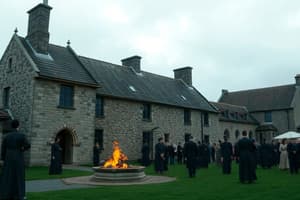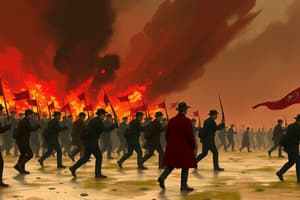Podcast
Questions and Answers
What is a primary belief of the Protestant Unionists?
What is a primary belief of the Protestant Unionists?
- Support for the disarmament of the IRA
- Ulster must remain part of the UK (correct)
- Desire for Irish unity
- Focus on civil rights reforms
What color is typically associated with the Catholic Nationalists?
What color is typically associated with the Catholic Nationalists?
- Red
- Orange
- Green (correct)
- Blue
What was the role of the Orange Order?
What was the role of the Orange Order?
- Advocate for Catholic rights
- Promote peace between the communities
- Celebrate the anniversary of the Battle of the Boyne (correct)
- Support the disarmament of paramilitary groups
Which party was traditionally the most popular among Protestants from 1922 to 1972?
Which party was traditionally the most popular among Protestants from 1922 to 1972?
What was a significant action taken by Gerry Adams regarding British Parliament?
What was a significant action taken by Gerry Adams regarding British Parliament?
How did the Catholic Nationalists view their connection to Ireland?
How did the Catholic Nationalists view their connection to Ireland?
What was the typical stance of moderate Catholics during the conflict?
What was the typical stance of moderate Catholics during the conflict?
Which political party emerged in the 1980s advocating for a more radical approach?
Which political party emerged in the 1980s advocating for a more radical approach?
What was the key reason that Protestant Loyalists opposed any power-sharing?
What was the key reason that Protestant Loyalists opposed any power-sharing?
Which group believed the violence they experienced was defensive rather than aggressive?
Which group believed the violence they experienced was defensive rather than aggressive?
Flashcards
Irish Republicans
Irish Republicans
A political movement advocating for the union of Northern Ireland with the Republic of Ireland. They believe Northern Ireland is illegally separated from the rest of Ireland and strive for a united Ireland.
Ulster Unionists
Ulster Unionists
The political movement advocating for Northern Ireland to remain a part of the United Kingdom. Their main goal is to preserve the union with Britain.
Democratic Unionist Party (DUP)
Democratic Unionist Party (DUP)
A Protestant political organization in Northern Ireland, known for its strong opposition to any form of power-sharing with Catholics, and considered a major influence in the conflict.
Social Democratic and Labour Party (SDLP)
Social Democratic and Labour Party (SDLP)
Signup and view all the flashcards
Sinn Féin
Sinn Féin
Signup and view all the flashcards
Irish Nationalists
Irish Nationalists
Signup and view all the flashcards
Ulster Unionist Party (UUP)
Ulster Unionist Party (UUP)
Signup and view all the flashcards
The Troubles
The Troubles
Signup and view all the flashcards
Irish Republican Army (IRA)
Irish Republican Army (IRA)
Signup and view all the flashcards
Sectarianism
Sectarianism
Signup and view all the flashcards
Study Notes
The Two Sides of the Conflict
-
Protestant Unionists/Loyalists:
- Believed Ulster should remain part of the UK, loyal to the British monarch.
- Viewed the Troubles as a police issue, with criminals and terrorists deserving punishment.
- Initially resisted political reforms and power-sharing.
- Associated with the color orange, referencing William of Orange.
- Celebrated the anniversary of the Battle of the Boyne.
- The Orange Order is a strongly unionist Protestant organization.
-
Catholic/Nationalists/Republicans:
- Felt unjustly separated from Ireland.
- Prioritized Irish identity over British.
- Sought unification with the Irish Republic.
- Inspired by the American civil rights movement.
- Emphasized self-defense in the face of violence.
- Typically demanded substantial reforms before discussing IRA disarmament.
- Associated with the color green, representing Ireland.
Community Divisions
- Neighborhood Segregation:
- Protestants and Catholics often lived in separate neighborhoods.
- Physical barriers like fences separated these areas.
- Distinct communities developed with their own schools, workplaces, shops, and pubs.
- There was a mutual avoidance between the communities.
Different Perspectives on the Conflict
-
Catholics:
- Disliked division and Protestant dominance.
- Recognized the difficulty of Northern Ireland joining the Republic.
- The Social Democratic and Labour Party (SDLP) was often supported by moderate Catholics aiming for lawful unification.
- Sinn Féin, the radical political wing of the IRA, increasingly involved in elections in the 1980s, rejecting British authority.
- Some Catholics justified IRA violence as necessary, asserting it had the sole purpose of forcing British withdrawal.
-
Protestants:
- The Ulster Unionist Party (UUP) historically governed, seeking to maintain Ulster within the UK while retaining autonomy.
- Closely aligned with the Conservatives until 1974.
- The Democratic Unionist Party (DUP), founded by Ian Paisley and fundamentalist Protestants, opposed any compromise with Catholics.
- Supported by the Ulster Defence Association (UDA) and Ulster Volunteer Force (UVF), which used violence as a tactic.
Political Stalemate
- Failed Attempts at Resolution:
- Successive UK governments attempted political solutions to the conflict between 1972 and the mid-1990s.
- Efforts were unsuccessful due to differing demands.
- The IRA consistently sought the Irish Republic as the only solution to the conflict.
- Protestants vehemently rejected any measure granting more power to the Catholics.
Studying That Suits You
Use AI to generate personalized quizzes and flashcards to suit your learning preferences.




